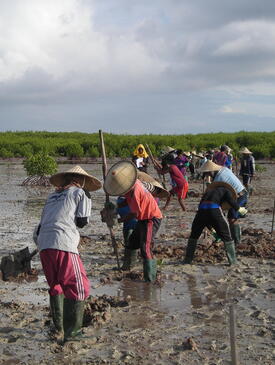Training on Ecological Mangrove Rehabilitation
Summary
Globally and nationally, planting is the most common mangrove rehabilitation method carried out by stakeholders in the region. However, this active restoration strategy often has a low success rate. Many mangrove areas have been converted to other land uses, leading to mangroves being planted in unsuitable locations, such as mudflats and seagrass beds, that historically did not support mangrove growth. These sites are often situated below mean sea level, where mangroves cannot survive due to physiological limitations.
Effective mangrove rehabilitation requires a thorough understanding of the drivers of mangrove deforestation and degradation, as well as efforts to address these underlying threats. In many cases, planting is unnecessary, as mangroves naturally produce hundreds of thousands of propagules per tree each year. By restoring appropriate hydrological conditions, these propagules can disperse and regenerate naturally. Planting may be used to support natural regeneration after hydrological restoration has been implemented.
This online training focuses on the Ecological Mangrove Rehabilitation (EMR) approach, which integrates social, economic, and ecological considerations in mangrove restoration. EMR employs various methods, including hydrological repair, natural regeneration, and community involvement. The training will showcase lessons learned from EMR-based mangrove rehabilitation efforts in several regions of Indonesia, presented by Ben Brown (Co-founder of Blue Forests), along with case studies from other regions presented by Andre Rovai (Senior Scientist at the Smithsonian Environmental Research Center).
Join our Indonesia Online Training on Ecological Mangrove Rehabilitation. Register today.
Content
- Ecological Mangrove Rehabilitation Approach


